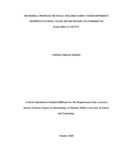| dc.description.abstract | The River Isiukhu watershed is endowed with rich agricultural soils. However, the region is characterized with high population density and therefore farm land is under enormous pressure as it is put under continuous production of crop to meet the ever growing food demand and source of livelihoods. On the other hand, crop rotations to rejuvenate the soils have been limited by the small farm sizes, while application of soil fertility amendments has been hindered by the high cost of inputs, and therefore communities depending on agriculture productivity have continued to suffer from low crop yields. Additionally, how farming practices within the region impact on the soil physicochemical structure and microbial community is least understood. Farmers have therefore continued to employ the same farming practices overtime without considering the effects of the practices on soils in the region. This study aimed at determining the soil microbial profiles, physicochemical parameters and understanding the relationshipbetween soil physicochemical properties and microbial profiles under different cropping system. Three cropping systems commonly practiced by farmers in the study area namely, maize and bean intercrops, pure sugarcane fields, napier grass fodder fields were evaluated, whereas a site within the Kakamega tropical forest was considered to represent an undisturbed site. For each system, soil microbial community composition was determined using Illumina Miseq sequence data of 16S rRNA gene and ITS region for bacteria and fungi respectively. Soil organic carbon and total nitrogen were determined using Walkley-Black method, Kjeldahl digestion method respectively. The highest levels of soil organic carbon (37.03 Mg/ha) and total nitrogen (3.27 Mg/h) were recorded in maize and beans intercrop system while the least, 27.15 Mg/ha and 2.38 Mg/ha, respectively from napier cropping system. The results showed the presence of 20 bacterial phyla and 3 fungal phyla across all the treatments. Acidobacteria(30.2%), Proteobacteria(19.6%), Verrucomicrobia (12.3%) and Actinobacteria(7.8%) were found to be the main dominant phyla in all the treatments. Under fungal community structure, Ascomycetes(65.4%) and Basidiomycetes(19.2%) were the main dominant phyla. The relative abundance of Proteobacteriawas recorded highest in forest and lowest in sugarcane. Acidobacteriaon the other hand was recorded highest in maize and beans intercrop and lowest in forest. Under bacteria, Chao1 diversity index was less in sugarcane and more under forest. The Shannon diversity index was greater in forest and least under sugarcane cropping system. When comparing the fungi diversity, Chao 1 diversity index was more in sugarcane cropping systemand less under maize and beans intercrop. The Shannon diversity index was great under sugarcane and least under napier cropping system. In this study Acidobacteria and Chloroflexiwere positively correlated with SOC while Basidiomyceteswas found to have a negative correlation. Total nitrogen (TN) was positively correlated to Planctomycetesand Ascomycetes. Only Acidobacteriashowed a positive correlation with pH. These findings reveal that the different cropping systems practiced in the area influence soil carbon, total nitrogen, pH and microbial soil profiles. The findings further show that the soils are only marginally acidic, but soils under napier appear to have the least levels of fertility and microbial populations and structure. This study thereforeprovides an insight of how different cropping systems influence soil microbial profiles and physicochemical properties and it could be used in the development of sustainable land management approaches with reference to cropping systems within the watershed. | en_US |

